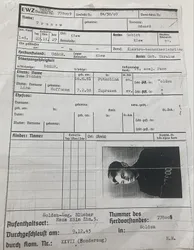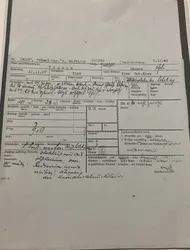Einwandererzentralstelle records, more commonly known as EWZ records, are German immigration records from the period of World War II. These records are valuable to those researching German relatives and ancestors who lived outside of Germany and applied for German citizenship from 1939-1945. [1]
Foreigners with German ancestry were thoroughly interviewed to confirm German ancestry and good health and to determine whether the applicants were worthy of being approved for immigration to Germany or areas controlled by Germany and citizenship. As a result, the information found in EWZ records provides details about the applicant's life and family history. Many files have the applicant's photo in the EWZ record.
Research your ancestors on MyHeritage
History of EWZ recordsHistory of EWZ records

Einwandererzentralstelle translates into English as "immigrant central office." It opened in October 1939 in Gotenhafen, now Gdynia, Poland. A month later, the main office was moved to Posen, which also is in Poland. The office moved again in spring 1940 to Berlin, Germany's capital. Its final location was in Lodz, but German officials renamed the town as Litzmannstadt under their occupation. [2]
People who came from the following countries are documented in EWZ records: Estonia, Latvia, Lithuania, Poland, Ukraine, Romania, Bulgaria, Soviet Union, Slovakia, Slovenia, Serbia, Croatia, Bosnia, Italy, France, Luxembourg, Switzerland, and Greece. [3]
Between 1939 and 1945, the Immigrant Central Office processed information on about 2.1 million ethnic Germans. Since the EWZ files contained information on German S.S., the U.S. Army took the records to the United States. About 80,000 records were burned before the U.S. Army took the records. [4] German archives received the EWZ files from the USA in 1994. [5]
Hitler had the goal of bringing together ethnic Germans on lands Germany controlled. Many Germans living abroad were forced to leave the Soviet Union or didn't want to live in Soviet-controlled areas. [6]
For example, U.S.S.R premier Joseph Stalin deported more than 400,000 Volga Germans from the Soviet Union in 1941. The Nazis also took Russian passports from ethnic Germans living in southern Russia and gave them German passports during Operation Barbarossa in June 1941. The Nazis had the goal of taking over the areas considered European in the former Soviet Union and relocating people with German ancestry to that area.[7]
Understanding EWZ recordsUnderstanding EWZ records
EWZ records come in three parts: applications, basic card index, and family forms. The basic card index provides biographical information on those who registered for naturalization. The family forms have information on parents and grandparents.[8]
Many records are microfilmed at U.S. Archives in College Park, Maryland, and the Family History Library in Salt Lake City, Utah. U.S. Archives has all three parts on microfilm, but microfilms at the Family History Library only have the basic card index and family forms.[9]
The collection of EWZ records are divided into countries as follows: EWZ50, USSR; EWZ51, Romania; EWZ52, Poland; EWZ53, Baltic countries; EWZ5410, Yugoslavia; EWZ5420, Romania; and EWZ5430; Bulgaria.[10]
The catalog for the EWZ records FamilySearch microfilmed can be found on this web page.
The type of information that can be found on EWZ records includes number of children and those who are living, history of major illnesses and vaccinations, names of siblings and where they live, work history, knowledge of languages, and background in education.
Requesting the recordsRequesting the records

EWZ records have been microfilmed by NARA and FamilySearch, but the original records are maintained by the Federal Archives of Germany (Bundesarchiv) at the Lichterfelde branch archives. [11]The archive can be contacted on this web page.
Before visiting NARA's College Park branch or FamilySearch Library in Salt Lake City to view microfilms of EWZ records, researchers can search the war records on Odessa, a comprehensive indexing database of EWZ records. Odessa provides names, birth dates/birth years, birthplaces, and record locations within the microfilms. The database, which is available in English, includes relatives mentioned in EWZ records.
Some genealogical societies have purchased microfilm rolls of the EWZ records and provide a search service for the records. Anyone in the USA can purchases the microfilms for $125 each (shipping fee included) from NARA. Purchases from abroad cost $135 per roll with shipping. Additional information on making purchases are posted on this NARA web page.
Explore more about EWZ filesExplore more about EWZ files
- German historical record collections on MyHeritage
- Research German Ancestors on MyHeritage, article by James M. Beidler on the MyHeritage Knowledge Base
- Researching Your German Ancestors, webinar by Kory Meyerink on Legacy Family Tree Webinars
- East European Emigration and the EWZ by Dave Obee
- Odessa- A German-Russian Genealogical Library's indexed EWZ records (under war records)
References
- ↑ "Einwandererzentralstelle (EWZ) microfilms," Dave Obee, https://www.volhynia.com/res-ewz.html
- ↑ "Immigration Centre," Thomas Pruschwitz, https://recherche-bundesarchiv.de/en/immigrant-central-office/
- ↑ "Immigration Centre," Thomas Pruschwitz, https://recherche-bundesarchiv.de/en/immigrant-central-office/
- ↑ "The 1940s: Forced from their homes," Dave Obee, http://www.daveobee.com/links/euro-ewz.htm
- ↑ "Einwandererzentralstelle (EWZ) collection," Mennonite Archives of Ontario, https://uwaterloo.ca/mennonite-archives-ontario/discrete-single-items/microfilm-collections/einwandererzentralstelle-ewz-collection
- ↑ "1939 Resettlement (EWZ) Records Help Page," Galizien German Descendants, https://www.galiziengermandescendants.org/cms/en/research?view=article&id=121:bcd2-help&catid=16
- ↑ "German EWZ Records," NORKA, Steven H. Schreiber, https://www.norkarussia.info/german-ewz-records.html
- ↑ "Einwandererzentralstelle (EWZ) microfilms," Dave Obee, https://www.volhynia.com/res-ewz.html
- ↑ "Einwandererzentralstelle (EWZ) microfilms," Dave Obee, https://www.volhynia.com/res-ewz.html
- ↑ "Einwandererzentralstelle (EWZ) microfilms," Dave Obee, https://www.volhynia.com/res-ewz.html
- ↑ "Einwandererzentralstelle (EWZ) collection," Mennonite Archives of Ontario,https://uwaterloo.ca/mennonite-archives-ontario/discrete-single-items/microfilm-collections/einwandererzentralstelle-ewz-collection

